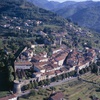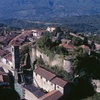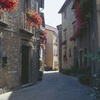Castle of Castiglione di Garfagnana
The walls that surround the outside of the castle have an irregular shape and are still well preserved along the entire perimeter. You can still see the openings for cannons and slits for archers. There are outbuildings, eight semi-circular towers and three main gates, one on the south and the others east and west respectively.
Even the fort remains almost intact, maintaining its form with three massive scarped semi-circular towers, equipped with slender corbels, and a smaller square tower, positioned to guard the entrance to the small fortification, accessible only via a steep staircase.
A visit to the Church of Saint Michael is highly recommended and not just for its remarkable facade, designed with characteristic Collemandina red marble, quarried from Sassorosso. Inside you can find a 14th century painting of the Madonna by Giuliano Simone, a 14th century wooden crucifix and a tabernacle by Matteo Civitali. In the early 17th century, following attacks by the House of Este, the church was badly damaged and during the siege of 1603 its bells were melted down for a piece of artillery.
The Church of St. Peter, the oldest church in the town, was first mentioned in 723. Inside is an antependium of “Our Lady of Seven Sorrows”, an inlaid work of the maestro Carlo Gibertoni.
Historical notes
The castle, whose existence was documented for the first time in 1033, suffered the vicissitudes of the noble local factions, until they fell under the dominion of the City of Lucca.
In 1306, the City of Lucca unified the Garfagnana region under its control and were responsible for the reconstruction of the defences of the castle and the building in the village of a new church. Five massive towers were then raised in 1371, following the failed attempt by Alderigo Antelminelli to take possession of part of the Garfagnana, and the castle was further strengthened under the rule of Paolo Guinigi.
Castiglione remained faithful to the Republic of Lucca in 1430, even when many dominions of the Garfagnana, threatened by the advance of troops led by the Florentine Niccolo Fortebraccio, were now entrusted to the magnanimity of Niccolo of Este. In 1452, Castiglione and other neighbouring communities were conferred upon the state of Lucca.
This status of enclave meant the of the House of Este with its artillery targeted Castiglione during the wars of the early 17th between Lucca and its dominions. The fortress twice withstood heavy sieges from the troops of Modena, thus proving the validity of its defence. Indeed, during the two assaults, only one tower was damaged to the point of rendering it irreparable.











